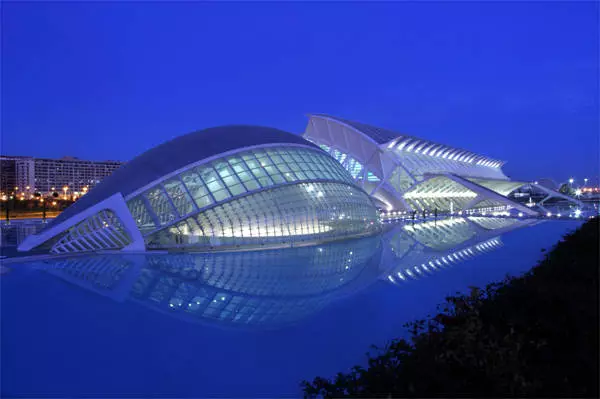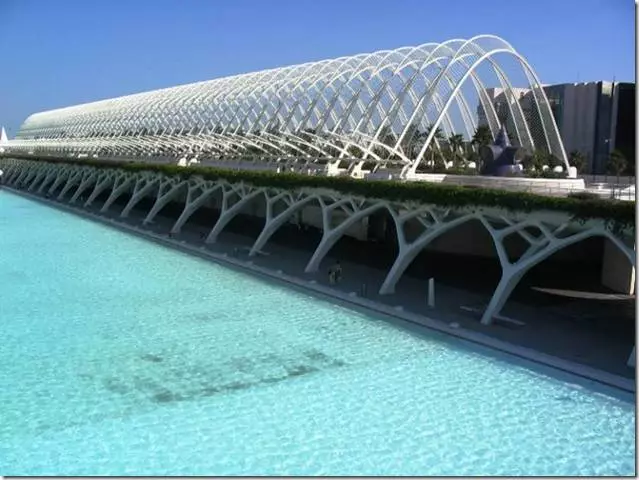Those who hear the name of the city of science and arts are often asked the question - what is it? Place where famous scientists and art historians work? Or maybe these are museums that are available for visiting only to scientists? Never that. The city of art and science, located in Valencia, is a huge complex consisting of five facilities, affordable and interesting for both residents of the city and tourists.
First of all, this complex attracts attention to its unusual architecture - it is an outstanding sample of modern architecture with all its signs - unusual forms, outstanding size, gorgeous illumination at night. This complex was created by the famous Spanish architect Santiago Kalatrava, which is the author of futuristic buildings around the world.

The city of science and arts consists of five parts - the opera theater, the IMAX cinema with the planetarium and the theater of laser productions, the garden, the Scientific Museum and the Oceanographic Park.
The Opera House is very popular both among the inhabitants of Valencia, and among numerous tourists visiting the city - tickets are bought back rather quickly and are not too cheap - because the stars are truly a world scale.
The cinema is located in the formation of a hemisphere and is the largest cinema in all of Spain, which can demonstrate both films in IMAX format and 3D movies. For children there are shifted cartoons with a scientific bias, and for adolescents and adult visitors, scientific films are offered, talking about our planet, conquering space, immersion in the depths of the ocean and many other things. On the day there are several sessions, tickets for which you can purchase both at the box office of the cinema itself and on the official website of the city of science and art (www.cac.es), which is available in Spanish and English. A cinema ticket is not very expensive, cheaper to purchase it on the site, an adult ticket is worth 4 euros (for one session), for children, retirees and large families are offered discounts.
Almost the biggest building in this complex is the aquarium. It is the largest oceanarium of Europe, it contains fish (from small tropical fish to the formidable sharks), mammals (including dolphins). Also live marine seals, walruses, beluga and many other animals and reptiles. The whole oceanarium is divided into thematic zones, each of which tells visitors about a particular corner of our planet. There is a Mediterranean zone, the Arctic and Antarctic zone, the tropical seas, the Red Sea and even the zone of the swamp. The oceanarium is so huge that if you carefully examine all its inhabitants, you can spend there without exaggeration all day.

In addition, the oceanarium includes dolphinarium, where submissions are held. The oceanarium is open to visit all the days of the week, but the schedule depends on the season - in the so-called low season (from January to June and from October to December) it works from 10 to 18 hours from Sunday to Friday and from 10 to 19 hours on Saturdays. On the average season (from the middle to the end of June, and from the middle to the end of September), the time of his work increases for an hour, and in the highest season (from July 18 to August 31) it is open to a visit from 10 am to midnight. The entrance ticket for an adult will cost you at 27, 90 euros, and for preferential categories of citizens, it will cost 21 euros. Near the oceanarium there is a paid parking, the parking hour on which you will cost you 2, 30 euros, but at the same time you pay no more than 24 euros for all day.
The complex of the city of Science and Art also includes, in fact, the Museum of Science itself. The Museum itself is interactive, that is, visitors are invited not to just look at the exhibits, but to actually actuate the various mechanisms, participate in experiments, that is, be a not passive observer, but an active researcher. A separate part of the exposition is devoted to experiments with electricity, there are optical illusions there, as well as processes such as gravity, movement and many others are investigated. There is a separate exhibition for children - in a simple and understandable form for them, they are talking about the processes passing in the world around us. During the low season, the science museum is open from 10 to 18 hours from Monday to Thursday and from 10 to 19 hours from Friday to Sunday. During the middle season, the museum works from 10 to 19, and in high season it is open to a visit from 10 to 21 hours. The entrance ticket for adults will cost you in 8 euros, and for preferential categories of citizens only at 6, 20 euros. When buying tickets on the official website you will receive a 10 percent discount.

And finally, the complex of the city of Science and Art includes a garden in which exotic plants grow, as well as plants typical of the Mediterranean zone. There you can break a little and walk.
General tickets are also sold in the complex (there may be a visit to the oceanarium and, for example, the museum of science), but I would recommend you to count your forces - first, the city of science and art occupies a huge square, which is purely physically difficult to get around for one Day, secondly, all exhibitions are very saturated with information, so that switching from the oceanarium on the science museum can be complicated. However, if you easily absorb new information and quickly oriented, you can try to visit all buildings of the complex in one day.
How to get to the city of science and art? It is not in the historic center of the city, and you can get there by car, bus or subway. The nearest metro station to the complex is called La Alameda, you will need to take a little walk before entering the complex (it will take you no more than 10-15 minutes). You can also come there online - near the complex stops buses with rooms 1, 13, 14.15, 19, 35, 95 and 40. If you rent a car, and you want to get to the complex yourself, then use the following GPS coordinates : Coordinates of aquarium - 39º 27 '9' 'n, 0º 20' 53 '' w, coordinates of the museum of science - 39º 27 '23' 'n, 0º 21' 10 '' w, coordinates of the cinema - 39º 27 '22' 'n 0º 21 '12' 'w. If you decide to come there for a taxi, tell me that you need a city of science and arts - (in Spanish Ciudad de las Artes Y Ciencias), you will be understood.
